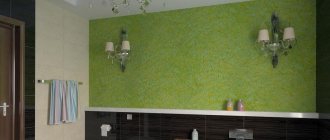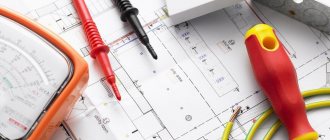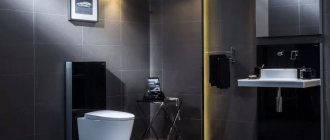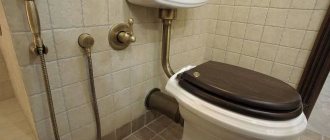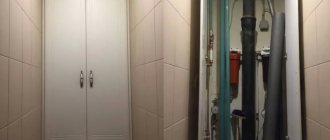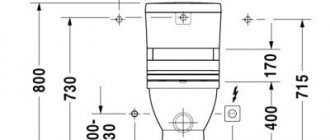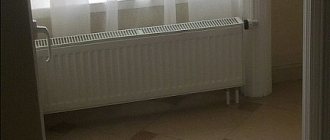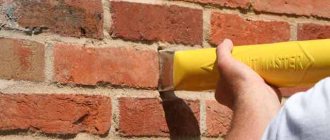The minimum distance from the toilet to the wall is a parameter determined by SNiP 2.08.01-89 “Residential Buildings”. SNiP are building codes and regulations developed back in Soviet times. But the distance from the wall to the toilet is not just the distance dictated by SNiP or GOST, because there are some standards in the production of building parts and plumbing equipment. These are documented optimal parameters obtained in a reliable way.
Toilet in the toilet
Which flooring to choose
For the ergonomics of the bathroom, it is very important to choose the right flooring.
The floor should not be slippery, as this can lead to accidents. The main types of materials used in bathrooms and toilets are:
Tiles in the toilet
- Non-slip ceramic tiles;
- Laminate;
- Linoleum.
You need to choose very carefully. It should have a slightly rough structure so that it does not slip when wet. Typically, Italian ceramic tiles are of much higher quality than domestic ones and have a longer service life. Tile flooring has many advantages:
- This coating is abrasion-resistant and can be washed and cleaned without fear;
- Moisture resistance;
- Durability;
- Beautiful appearance.
There is only one drawback - ceramic tiles are afraid of mechanical damage; you cannot drop various objects on them, as they can deteriorate irrevocably.
By choosing laminate for your bath, you get a beautiful floor covering that can imitate expensive wood. Even a novice master can install laminate in a bathroom, the main thing is to fit the joints well. If the joints are poorly fitted, then moisture can get into them and the laminate will be deformed and damaged. It is advisable to lay special mats on top of the laminate; such a coating becomes slippery when exposed to water.
Linoleum bathroom
You can lay linoleum in the bathroom. This flooring is inexpensive, beautiful, is not afraid of moisture, and is easy to lay on the floor. However, when wet, linoleum is very slippery, so it is also necessary to use special bathroom mats.
Heated floors in bathrooms have proven themselves well, this is especially true for combined toilets with a bathtub. Such floors are pleasant to walk on with bare feet and do not require an additional source of heating in the room.
What toilets are considered standard in old and new apartments
The area of the toilet in the apartment has always been determined according to SNiP standards. In recent decades, these indicators have not changed; at least the minimum sizes have definitely remained unchanged. Old-style apartments rarely boasted large bathroom options, but even in a limited area you can create a comfortable and convenient space with enough free space.
When planning the interior of a small toilet, experts recommend adhering to the following rules:
In old apartments there are rarely toilets with a large area
- Take careful measurements of the room and draw a diagram of the room, taking into account all sizes, niches and openings.
- Think over the floor plan in detail, draw all the plumbing fixtures taking into account the dimensions and see if everything will fit in the room and whether there will be enough free space for unhindered movement. At this stage, you can determine the number of devices in order to understand what you can refuse.
- Arrange niches and corners. To properly organize a small space, it is recommended to use built-in and wall-mounted structures to the maximum. To save space, you can install an installation for a toilet in a niche or make a built-in closet for small items.
It is also important to think in advance about the dimensions of the selected plumbing fixtures. If the toilet is small, you should not purchase a toilet with a depth of more than 60 cm, because it will be inconvenient to use on a large and incorrectly installed device.
In new buildings there are toilet rooms with an area of 4 m² or more
As for modern layouts in new buildings, here, as a rule, a large area is allocated for the bathroom. Modern apartments with a small area are usually distinguished by the presence of a toilet measuring about 4 m², while apartments larger than 60 m² can boast either a separate bathroom or a large toilet combined with a bathtub, the size of which reaches 6 m².
Also, modern luxury housing can be complemented by a toilet, the size of which is 9 m². This area will be enough to create the most comfortable room with all household appliances, spacious cabinets for linen and household chemicals. In some cases, such a large bathroom is equipped with a built-in ironing board, which is convenient for ironing clothes.
If we talk about new buildings, then regardless of the size of the apartment, certain rules regarding the size of the bathroom are observed. Thus, in new one-room apartments, the area of this room allows you to freely place all the necessary elements: bathtub, toilet, sink. Often there is a corner left for installing a washing machine or a basket for dirty laundry.
The spacious toilet can be equipped with everything necessary for comfortable use
In two- and three-room apartments, a separate bathroom is most often planned. The layout of apartments measuring 80-100 m², depending on the total area of housing, provides two bathrooms of different sizes. The recommended sizes of doors to the toilet are openings of 55-60 cm, excluding the width of the jambs.
How to rationally equip a bathroom
In a modern home, be it a standard apartment or a private house, there is always both a bathroom and a toilet room, or a combined version of them. In most cases, they are not too large, but it is quite possible to allocate the necessary space for a sanitary area and a bathing area. Before purchasing plumbing fixtures, you need to measure the area of the room and determine the locations for the sink, bathtub and other equipment, taking into account the recommended rules and regulations for their installation.
It is recommended to install the bidet next to the toilet, at a distance of at least 60 cm.
When organizing space in the bathroom, you should take into account ergonomics and observe rational placement. It is necessary to determine in advance and accurately the maximum comfortable distance between the toilet and the bidet. There are no clear regulations on the size of this distance; its choice is quite arbitrary, but it must be taken into account that the distance from the sewer riser to the toilet is 1 m, and the rest of the plumbing is placed no further than 3 m.
It is advisable to make the free distance in front of each device at least 60 cm (an area of 70x100 cm will be more convenient), and on each side you need to leave 25-30 cm. The direct distance between the bidet and the toilet, according to the advice of experts, can be made from 30 cm to 45 cm A shorter distance will not be enough to use plumbing, and a larger distance will not be very convenient. From the appliances to the washbasin, if it is provided in a sanitary area, there is a gap of at least 25 cm.
Distances between plumbing elements
In order to safely and conveniently use the bathroom, certain minimum gaps between its elements must be observed.
Distances between plumbing elements:
Considering these recommendations, you will be able to ergonomically arrange your bathroom so that using the plumbing is comfortable, easy to care for and keep clean. Various design techniques will help implement these plans even in the smallest room, for example, you can look at how to place a washing machine (under the sink countertop or in a niche), choosing a convenient bathroom or washbasin configuration to save space.
It is very important to comply with these parameters in the bathroom, despite the apparent simplicity of this issue. In fact, it is almost impossible to organize such a premises in compliance with all sanitary and safety standards without observing these parameters. In addition, such standards ensure fairly comfortable use of all plumbing fixtures for all family members, as well as for your guests, regardless of their body type. Such standards also provide the opportunity to thoroughly clean the bathroom and treat it with special products, if necessary.
Therefore, before we start planning, we should collect all the dimensions of the plumbing fixtures and equipment that we plan to install. In this case, you need to go shopping and write down all the dimensions of the planned equipment. It is advisable to look for alternatives in advance and write down all the data for several options. Then you need to correctly take the dimensions of the room and draw a plan for the placement of all elements on a sheet of paper. For this, it is convenient to use graph paper, but if you don’t have it on hand, then a simple checkered piece of paper from a school notebook will do.
Source
Distance from the wall to the toilet optimal layout
During the renovation of a toilet and bathroom, when replacing plumbing fixtures, the problem of proper bathroom layout arises. One of the most important convenience parameters is the distance between the toilet and the wall, since if it is chosen incorrectly, using the device will be uncomfortable.
We will look at the regulatory requirements and find out what specific basic distances are determined by the instructions.
Bathroom remodeling
Separate toilet placement
Let's start with a simpler case, when the toilet is separated from the bathroom. It is simpler due to the fact that in such a toilet, in most cases, there is one device. In a larger package, it is possible to add a bidet, if the size of the room allows it.
We will immediately announce the standards for the distance from the wall to the toilet, adopted in SNiP 2.08.01-89 * “Residential buildings”:
Note! Official standards are mandatory for public and private construction of objects. Apartment owners will be able not to make them and place the devices at their own discretion, since their operation and maintenance are carried out by them
I would like to state that these standards are relevant in the case when the toilet is quite spacious, and you do not understand where it is better to put this or that device. But in most post-Soviet apartments this problem does not arise, since the dimensions of the toilet are minimal, and the toilet is placed in the middle of the cubicle near the back wall.
Note! Most of the Soviet-era toilet stalls have dimensions such that installing the compact exactly in the middle of the room near the back wall gives the very minimum distances to the side walls and the front door. Combined bathroom
Combined bathroom
If the toilet and bathroom are in the same room, the task is a little complicated by the fact that you need to rationally place a couple of plumbing fixtures in a fairly small room.
Additional troubles may result from the need to install household appliances - washing machine, boiler, etc. Along with this, the most acceptable layout option involves not only rational and ergonomic, but also harmonious placement of all objects from a design standpoint.
This is another feature of modernity: people want to live comfortably and beautifully, and this, as we know, cannot be prohibited.
If the bathroom is large, then you need to divide its premises into areas: the area of the shower or bathtub, the area of the washbasin, the area of the toilet, etc. But in most Soviet and many modern apartments there is no room for freedom, and the task comes down to meeting the minimum requirements for the distance between neighboring devices, devices and walls and the presence of passages.
Quite often, a compact and a bidet, and from time to time a washbasin, are placed in a line against the wall. In this case, there should be a gap of at least 20 cm between adjacent devices, preferably 30 cm. This means the distance from edge to edge.
If there is a sink next to the toilet, and it is also approached from the side of the appliance, then you must not forget about the space for tilting: while washing, a person leans towards the sink and moves back a little. The minimum space for this should be at least 70 cm.
Note! The dimensions of the distances to the side walls are taken without transformations - 38 - 45 cm from the middle axis of the bowl to the wall. Similarly, the requirement for the distance in front of the toilet does not change - it is at least 53 cm, for comfortable use - 76 cm
Here it is possible to make adjustments only on a large scale.
For combined bathrooms, the issue of saving space is very relevant. One example of such savings is a toilet with a tank in the wall. Installing this model with your own hands is complicated, but the use of modern installations and kits with frames simplifies this task.
When remodeling bathrooms and restrooms, take into account the distances between adjacent devices, and do not forget about the distances from the wall (see also the article “Bidet toilet: purpose and design features”).
Types and design features
The dimensions of toilets depend on the design. So it is necessary to familiarize yourself with them. At the same time, we’ll find out which types can be installed in small bathrooms.
You don’t always immediately understand what and where
Bowl shape
The types of toilets based on the flush or bowl shape determine the ease of use and the level of “odors” that may be present. The minimum and maximum dimensions also depend on the shape. There are three types of bowls or drain:
Standard toilet sizes depend on the type of bowls
- Dish-shaped or with a shelf. The drain is moved closer to the front wall, and the bowl has a protrusion, which some call a shelf, and others a plate. Hence the names of the forms. With this device, there will be splashes when draining, which is unpleasant, but at least you won’t feel them. However, a toilet with a shelf is the most “fragrant”. The excrement remains “on the shelf” until it is washed off, so the smell is intense.
- Kozyrkovy. The drain is also closer to the front wall, but the back wall of the bowl is flat, with a slight slope towards the drain funnel. With this design, waste falls on the back wall and slides along it into the water. There is no splash, the smell is present, but not so intense. Traces remain, even though the main source is in the water.
- Funnel-shaped. The shape of the bowl of this toilet is similar to a regular funnel. The drain is almost in the middle. There will be almost no smell, but you will feel the splash. Literally. You can fight splashes either by moving forward/backward, as the dimensions (of yours and the toilet) allow, or by first throwing a piece of toilet paper into the water.
Which toilet is better to choose? In general, it’s not a bad visor. No splashes, with a tolerable level of “aroma”. However, after each use you will have to use a brush. But you quickly get used to this procedure.
Installation method
Depending on the installation method, there are two types of toilets: floor-mounted and wall-hung. With floor-mounted ones everything is clear; they are installed on the floor and secured to it. They come in two types. The first one is familiar to us with a tank on a remote shelf or with a tank on the wall. The second type is wall-mounted. We recently got this option. It differs in that the back wall is almost completely parallel to the wall.
Most toilets are installed on the floor. There are regular models and wall-mounted ones. There are also hanging ones. They require a special frame, which is hidden behind a false wall. This frame is called an installation
A wall-hung or built-in toilet is not attached to the wall, as it might seem, but to a structure that is hidden behind a false wall. This design is called "installation". This is a metal frame that is bolted to the walls and floor. And not only the bowl, but also the button and all the pipes are attached to this frame.
Release
This is not all the design features. We still need to sort out the release. This is the outlet pipe through which the toilet is connected to the sewer. The most compact models with a vertical pipe outlet. The longest ones are oblique. But they are the ones that are more common, since there is no need to lift the sewer pipe, but you can only install a tee and insert a corrugation into it.
There are also three forms of toilet outlets: straight, oblique and vertical. Vertical ones are now very rare, although you can find them if you want. This standard is used in America. But anything can be made to order. By the way, it is the toilets with vertical outlet that will have the smallest “depth”. And with such an output they usually make wall-mounted models.
The outlet of a toilet is its outlet pipe. They come in three types: straight (horizontal), oblique and vertical.
How to choose a toilet by release? If you are just replacing the toilet and don’t plan to redo the sewer system, there is really no choice. You need it with the same release that was. No options. When replacing sewer pipes in an apartment, it will be possible to change the oblique to a straight one, or vice versa - a straight to an oblique one. But it won’t be possible to install a vertical one - the drain must go vertically downwards, that is, to your neighbors below. This means that they will have to make a replacement too. When should you choose a vertical drain? In a private house, it is better on the ground floor. In the underground or basement, the pipe will not bother anyone. And the advantage of this type has already been announced - this is the minimum “depth”.
Types of toilet cisterns
Before you deal with standard toilet sizes, you also need to think about the type of tank. This also affects the size. For example, the popular compact model is far from the “shortest”. Here the palm goes to models with a separate wall-mounted tank. But we must also take into account the pipe with which the tank and toilet are connected.
Toilet tanks also affect the size. Often they are either an integral part or cast in a single mold
In general, there are three types of toilet cisterns: separate (wall-mounted), compact and monoblock. Compact and monoblock can be straight or angular. Corner models are usually the smallest. And they definitely allow you to save space in a small toilet.
What are the differences between the tanks? There is no fundamental difference. It's a matter of the owners' preferences, and, well, appearance. A monoblock is when the bowl and tank are cast in a single form and cannot be separated. Compact is when the tank is installed on the back of the bowl. In such models, the bowl has a special outlet behind it with holes for attaching the tank. What's good about this option? You can change tanks. Not only if the old one cracked, but also if you missed the shape or volume. This also happens. Wall-mounted tanks have the same advantages. The only difference is that you will have to fasten them and install a connecting pipe.
The least amount of installation space is required for the dryer. This is a tankless drain system
By the way, there are toilets without tanks. These are not those in which they are hidden in the installation, but those that are directly connected to the water supply. This model is used in Germany, and we also have it in some public toilets. Its main advantage is saving space. Whatever one may say, the tank takes up space. If space is really tight, you can install one like this. True, provided that there is enough pressure in your system for it to work.
Ergonomics of the bathroom and toilet rooms
13.03.2009 17:54
(60 ratings, average: 4.17 out of 5)
To My World
Every time a renovation is planned, it is necessary to start with the so-called wet areas - the bathroom, toilet and kitchen. These rooms are the most difficult when planning and calculating ergonomic space.
When reconstructing (repairing) a bathroom, the necessary conditions are taken into account, namely:
- The toilet must be located near the sewer riser; if this is not taken into account, then the toilet is placed above the floor level.
- The sink must be placed at a height of 85-90 cm from the floor level.
- In small bathrooms (less than 15 m2), for safety reasons, it is prohibited to install sockets and switches; they are located in front of the entrance to the room.
- In cases where the bathroom is more than 15 m2, you can install sockets for various equipment: heated towel rails, hair dryers, saunas, TVs and even electric fireplaces.
- Heated towel rails are located next to the riser for connecting to hot water. Electric heated towel rails can be installed at any height from the floor and next to an outlet.
What sizes are toilets?
Standard toilet sizes are designed for people of average height and build. Not everyone is like that. And a toilet with a shelf, which is described in GOST, is far from the best choice in terms of aromas. Also, most of the products in stores today are imported. And they have their own standards. For example, the European standard toilet size is 680*360*400 mm (this is the length, width at the widest part and the last number is the height). The Americans went even further - their usual “depth” is 768 mm, width 380 mm, the height of the rim above the floor is still the same - 36-38 cm. As you can see, the standards are different, and not everything is made according to the standards. People have different needs and the market is trying to satisfy them.
There are very interesting models
Dimensions of floor models
As you understand, floor-standing toilet models are different and their sizes are also different. We will give a range, but we do not guarantee that there are no narrower or wider ones. Most likely, if you set a goal, you can find both.
Different styles, different sizes
Compact
The Compact type toilet (with a tank attached to the back) has the following dimensions:
- length - 610-645 mm;
- width from 345 mm to 420 mm;
- height from 370 mm to 395 mm.
Note that the narrowest bowls are more like a rectangle. They are not as round as we are used to. They are quite convenient to use. There may just be problems when buying a cover. This form is rare.
Dimensions of Compact floor-standing toilets
Without tank
A toilet without a shelf with a wall-mounted or separate tank has the following dimensions:
- length 435-460 mm (20 cm less than Compact models!);
- width 360-400 mm;
- rim height from floor level 350-390 m.
The dimensions of floor-standing toilets with separate tanks are more compact.
As you can see, they are more compact, despite the name given to the previous option. But such models are less popular, since the tank must be secured, and this is an additional headache. Previously, this type was considered a “relic”; now it is stylish and interesting. There are very interesting models (though they have interesting prices).
Warm floor
They can be either electric or flexible pipes with hot water. The connection and control panels for the electric floors are placed in front of the door to the bathroom.
Toilets
There are floor-standing ones with a tank (compacts), floor-standing ones with a built-in tank, hanging ones, and also combined with a bidet. Wall hung toilets require additional space to install the flush cistern into the wall.
| Optimal dimensions of a floor-standing toilet | Optimal washbasin sizes |
Bidet
There are floor and hanging ones. It is better to buy complete with a toilet, to maintain the style and shape of the same design (in wall-hung kits, all communications must be hidden under one panel). The bidet is installed next to the toilet at a distance of 15-20 cm.
Sinks
There are ceramic, glass, steel, acrylic, stone and wood. According to the type of fastening, they are divided into console sinks attached to the wall with brackets, standing on a stand (tulip type) and built-in sinks. The standard sink depth is 45 cm. The length of double sinks is 120-150 cm. The distance between the sink and the shower cabin is or the bathroom must be at least 30 cm.
| Necessary optimal sizes for washing in the bathroom |
| Necessary optimal dimensions for towel drying in the bathroom |
Baths
There is a wide variety of bathtubs made from different materials: Cast iron. They heat up quickly and retain heat for a long time. Such baths are not subject to corrosion. The only limitation is the design; there are no other shapes other than rectangular. Steel. Durable surface, but does not hold heat well. Acrylic (plastic). Such baths are durable, but do not retain heat. They come in a variety of shapes and sizes. Quarilic (a mixture of acrylic with quartz powder). Holds heat well, durable and scratch resistant. There are also Wooden, Onyx, Marble and Steel bathtubs. In terms of functionality, there are regular and hydromassage bathtubs. The choice of bathtub depends on the size of the bathroom. There is a direct relationship between the height and length of the bathtubs - the longer they are, the lower their height. Common bathtub sizes are 170x70 cm. There are also sitz bathtubs with lengths of 150x70 and 120x70 cm.
| Standard dimensions of a rectangular bathtub | Standard sizes of a round bathtub |
| Standard sizes of corner bathtubs | |
Shower cabins
There are shower cabins of various shapes and sizes. They are divided into simple and combined. Simple ones come with a tray of various shapes and glass or plastic door walls. Trays in shower cabins can be: ceramic, steel, cast iron, acrylic, marble chips. The minimum size of a shower tray is 80x80 cm. Combined shower cabins are combined hydromassage baths with a shower cabin. They significantly save space in the bathroom.
| Various options for placing plumbing fixtures in bathrooms |
| Various options for placing plumbing fixtures in showers and toilet rooms |
| Next > |
Updated (03/14/2009 20:50)
Classification of toilets by type of installation
This product can also be divided into two categories, depending on the installation method: floor-standing and hanging. Floor-mounted ones, in turn, are divided into subcategories: wall-mounted and simple.
Floor-standing
This is the most common type of toilet. It is characterized by ease of installation and low cost. Typically, floor-mounted structures are installed in a more or less spacious room; for a room with a small area, a wall-mounted option (compact flush system) is more suitable.
Installing plumbing fixtures using anchor bolts does not require much time. The advantage of this type is that the floor covering does not suffer during installation.
Hanging
This type of toilet is installed in small rooms and saves a lot of space. The toilet mount can withstand a load of up to 400 kg, but there are models that can withstand more.
When installing, the device bowl is attached directly to the wall, at a certain distance from the floor. It is secured using either a frame or block method. To save space, sometimes such a toilet is installed in a special niche in the wall.
SNiP norms 2.08.01-89
Until recently, the Russian Federation mainly used the standards of the Soviet state, which paid great attention to the construction, industrial, epidemiological and occupational safety of its citizens
Recognizing the appropriateness of the data presented in these documents, obtained not just empirically, but also on the basis of scientific research, the norms and rules were still used at the level of recommendations.
The court took them into account when resolving disputes, but could also ignore them. The creation of a state register of regulatory recommendations, norms and rules, as well as methodological guidelines led to the fact that the developed norms and rules in the field of construction, production and the national economy acquired the status of official and legally enshrined
The main condition for acceptance was compliance with the norms of Russian law
The creation of a state register of regulatory recommendations, norms and rules, as well as methodological guidelines led to the fact that the developed norms and rules in the field of construction, production and the national economy acquired the status of official and legally enshrined. The main condition for acceptance was compliance with the norms of Russian law.
Sanitary and hygienic standards (SanPiN) are not only not outdated, but have become even more relevant due to the deteriorating epidemiological and environmental situation. None of the adopted sets of rules, according to the laws of the Russian Federation and regulations of the Ministry of Health, should conflict with the standards of sanitation and hygiene.
Moving the toilet - possible risks
This type of work is associated with significant risks that the owners take on:
- increasing the length of water pipes leading to the toilet;
- increased likelihood of blockages;
- change in pipeline slope;
- the appearance of right angles in the water supply system;
- violation of standards.
Even if the toilet is moved close to the wall, it must be taken into account that an increase in the piping system leading to this equipment can lead to problems. For example, when flushing water, a vacuum is formed, which will lead to the breakdown of the water seal in all plumbing located near the equipment. The process is accompanied by loud gurgles and unpleasant odors.
For the same reason, blockages appear. After all, the pipe leading to the toilet has increased in length. This creates conditions for a greater concentration of sewage. To avoid these phenomena, it is necessary to comply with the requirements of SNiP (building codes and regulations). With this approach, you will not only reduce the likelihood of breakdowns to a minimum, but also save your health and money.
When calculating the required pipeline slope, you should take into account the standard, which states that for all elements with a diameter of 100 mm, the presented indicator must be at least 2 cm per meter. If there are parts with a diameter of 50 mm, laying should take place at a minimum slope of 3 cm per meter.
A reduced slope value slows down the movement of wastewater and provokes the formation of stagnation of sewage in the pipeline.
A large slope is also undesirable. In this case, water will flow at an increased speed, which will lead to the appearance of solid contaminants. The gradual accumulation of such formations will increasingly impede the flow of water, leading to clogging of the pipeline.
Compliance with SNiP is a key factor in the success of relocating a toilet. But when transferred by more than 1.5 m, these recommendations cannot be taken into account. If there is such a task, it is necessary to install forced sewerage. This is also true at a shorter distance, if there is no desire or opportunity to work on adjusting the slope and installing additional pipes.
sizes and distances
Designers, doctors and manufacturers of bathroom equipment have long been paying attention to
bathroom ergonomics. The results of numerous studies have made it possible to determine the sizes of equipment suitable for 90% of people and its rational placement
The remaining 10%, who have larger dimensions, have to either endure the inconvenience or increase the numbers by purchasing larger showers and leaving more space between the elements of the bathroom.
Unfortunately, bathrooms are often so small that ergonomics can only be a dream. However, it is worth at least approximately adhering to the rules, taking into account the available opportunities. Ideally, 75 cm of free space should be left between each piece of plumbing equipment, as well as between the equipment and the wall/door.
This does not apply to toilets and bidets.
should be approximately
35 to 45 cm
. If you leave a long distance, it can be inconvenient.
Distance from shower stall or bathtub to sink
can also be reduced
to 30 cm
, but no less than that.
The washbasin bowl should be above the floor at a height of 80-110 cm
. Ideally, 90 cm, unless, of course, the bathtub is used by people of average height.
, the height of the countertop of bathroom furniture should be the same.
(tables, cabinets, chests of drawers, sink holes, etc.).
If children do not have their own bathroom, you need to take care of a comfortable bench so that the child can easily perform hygiene procedures while looking at his reflection in the mirror.
When washing at the sink, a person bends over, which means that there should be enough space in front of the sink for this. You cannot install a washbasin in a tight nook if there is no free space of at least 55 cm
.
However, there should be enough space so that a person, when washing his face and brushing his teeth, does not rest his elbows on the walls.
As for the toilet, there should be at least 35-45 cm to the right and left of it - no matter whether there are walls or other pieces of equipment. There should be at least 50 cm in front of the toilet, regardless of what is located there - a door, a shower stall or a sink. It is better if at least 75 cm is left in front of the toilet
If this is a toilet stall, then its average size should be 168 by 92 cm
Better if in front of the toilet
At least 75 cm
will be left .
If this is a toilet stall
, then its average size should be
168 by 92 cm
.
It needs to be mounted slightly in front of the edge of the toilet (20-30 cm)
.
The height of the toilet paper holder
from the floor is
60-70 cm
.
If a stationary shower corner
, then its size should be
at least 75 by 75 cm
, and this is provided that people of average build will take a shower.
Ideally, a shower corner or shower stall
should be
at least 90 by 90 cm
.
Recommendations
There are factors why it is worth observing the standards for the location of the toilet even in non-standard rooms. Among the main reasons are the following:
- standardized parameters of the shape and size of household items that are installed in the bathroom or near the toilet (if combined);
- availability of optimal options for the location of sewer drainage node connections;
- fixed dimensions and shape of plumbing components;
- Features of toilet installation technology.
Household items that may be located near the toilet (sink, sink with cabinet, washing machine, dryer and others) are manufactured according to a single range of standards. The overall dimensions of the toilets also correspond to them. This means that non-compliance with GOSTs that determine the distance for installation may lead to a violation of ease of use in the use of all household items for complex purposes.
Regardless of the characteristics of the room, there are standards that determine the best result of using the toilet. What matters is the angle of inclination at which the drain and its inlet socket are located. Even if the room is not built according to a standard design, the value of this slope remains unchanged.
To comply with this requirement, it is necessary to place the toilet at the optimal distance from the sewer inlet. Placing it too close will make it difficult to flush. Positioning too far apart may result in subsequent deflection of the corrugated connector. As a result, under the influence of deformation, leaks may appear in the area of the connections of the corrugations and sockets.
Plumbing components are manufactured according to uniform standards.
This fact should be taken into account when choosing the location of the toilet. Incorrect selection of the distance may make it impossible to use some plumbing fixtures. For example, placing the housing too close to the shut-off valve may interfere with the operating stroke of its lever, which will lead to the impossibility of shutting off the water supply.
The toilet is installed on a vertical support, which has 2 or 4 holes for fasteners. Before installation, it is necessary to mark these fasteners. To do this, the device is installed at its final location. Marks are made through the mounting holes on the floor. If the toilet is located too close to the wall, marking will be extremely difficult.
To install fasteners, holes are drilled in the floor in accordance with the markings. After placing the toilet in place, fasteners are inserted into the holes - bolts or dowel-nails. Screwing in these fasteners will also be difficult if the toilet is located too close to the wall or other furnishings.
In the next video you will learn important nuances that need to be taken into account when installing a toilet.
SNiP Residential buildings on distance standards
The rules contained in the regulatory document are mandatory for the construction of any type of building - industrial, public, medical, educational and residential. However, there is an unspoken opinion that owners of premises in residential buildings and private buildings can deviate from the dictated standards if they themselves carry out their maintenance and operation.
Basically, such a retreat is made by the owners of premises with bathrooms, combined or frankly small. If the toilet is spacious enough, it is better to adhere to the established rules in order to use special rooms with convenience and safety:
- to the front (front) wall or wall with a door, if we are talking about a small toilet, the minimum distance is 53 cm. This is enough to not feel tightness in the knee joint;
- the maximum required distance from the frontal plane located in front of the seated person is 76 cm;
- the maximum distance from the front does not particularly need to be regulated, and if possible, the functional zone for a person can be more than a meter;
- from the middle axis of the toilet to the side wall, the established minimum is 40 cm. In some sources it is defined as 38 cm;
- the optimal distance from the central axis of the toilet is 45 cm. This is enough for comfortable operation of the plumbing fixture. But no one forbids installing at a greater distance, if the parameters of the allocated room allow it;
- in a separate toilet, the distance between the toilet and the wall on the left in standard buildings is usually equal to the distance to the wall on the right side;
- The location of the toilet in the toilet room is usually the center of the room, because the sewer pipe is supplied here. This also determines the position of the remaining toilets on the riser on the floors above and below;
- The second option for placing plumbing equipment is closer to the back wall. This does not make it possible to equip some kind of shelves or rack, but it is typical for the minimum dimensions of the toilet in apartments of standard construction, where the bathroom is separate;
- The toilet stall in Soviet-era houses was built according to size, when the central placement provided the necessary distances to the side wall and front surface with the entrance door located in it.
When arranging a shared bathroom, there are certain conditions that must be observed. These are standards for the distance of the toilet from other interior items that should be adhered to, even minimally.
But this is not a suitable option if the dimensions of one of the family members do not correspond to the average figures for which the building codes and standards are calculated.
Minimum and maximum parameters
According to the ergonomic features of toilets, there is a set of rules according to which their installation can be carried out. Very often, installation is carried out not in a separate room reserved for the toilet, but in a shared bathroom with a sink and shower. If you do not take into account the installation rules, you may encounter problems in the sanitary system.
Distance between toilet and sink
The toilet should be installed at a distance of 20 cm from the sink and further. When installing plumbing fixtures in a complex, you should take into account that the bathtub and shower stall are located at the same distance. When double sinks are installed, there should be at least 40 cm between them. The bidet (or hygienic shower), on the contrary, is located next to the toilet - the optimal distance is no more than 30 cm. This means the distance from edge to edge.
Distance from water supply
This indicator is calculated based on the type of toilet plumbing. With a typical installation method, it should be located at a distance of 18 cm from the water supply. The indicated parameter provides the distance from the center of the pipe to the top of the floor covering. If the toilet is installed through installation (a method in which the flush tank is built into the wall), the distance from the top of the floor covering to the turbine axis should be 23 centimeters.
Minimum distance to wall
According to the current SNiP standards, this distance to the walls is established in relation to the position of the toilet.
- From 53 to 76 cm - to the front, located frontally, or to the wall with the door, if we talk about a small toilet, the shortest distance is 53 cm. This is enough to not experience tightness in the knee area.
- The maximum sufficient distance from the front wall located in front of the seated person is 76 cm.
- From the middle of the toilet to the walls on the side, the accepted minimum is 40-45 cm. In some sources, the distance to the side walls is set at 38 cm.
The indicated standards are relevant for a separate room. It is advisable to carry out installation near the wall - both in a separate room and in a combined bathroom. Some users believe that the closer the toilet is located to the wall, the more comfort and convenience it will provide. However, plumbers do not recommend using this method, as it will subsequently make access to communications more difficult.
For practicality and comfort in servicing the toilet, it is recommended to install it in such a way that the flush tank is located at a distance of 5-10 cm from the wall.
The distance between the toilet and the riser is limited; the limiting factor is the slope angle, which should be 2-3 centimeters per meter of pipe. There are no regulations governing the maximum distance. However, the longer the sewer pipeline, the greater the risk that a gap will form during use. For example, with a 4-meter length, the height of the toilet base will need to be raised by 8 cm.
Other installation details
As you can see, there are many nuances and problems hidden in installing a toilet. The distance from the wall in this case is no less important an indicator than others, so experts recommend planning this kind of work in advance so as not to forget about anything and do everything in accordance with the standards.
Please note that when lifting the toilet above the base of the floor, it is not recommended to use wood for this purpose, since this material is susceptible to rotting as a result of the adverse effects of condensation. Having moved the plumbing fixture to an acceptable distance from the wall to the side of the toilet (the numbers are indicated above) and mounted the device, it is recommended to pour a concrete screed, which additionally requires the use of screws, dowels and special fasteners for plumbing fixtures
Only in this way will the device be securely fastened, and you can enjoy the comfortable use of plumbing without worrying about breakage
Having moved the plumbing fixture to the permissible distance from the wall to the side of the toilet (the numbers are indicated above) and mounted the device, it is recommended to pour a concrete screed, which additionally involves the use of screws, dowels and special fasteners for plumbing fixtures. Only in this way will the device be securely fastened, and you can enjoy the comfortable use of plumbing without worrying about breakage.
Now you know what rules and regulations to use. The distance from the wall to the toilet is an important indicator that makes daily visits to the toilet easier and more comfortable. When faced with the need for redevelopment, studying this kind of material will help you avoid common mistakes that are so often made by repairmen who have started redevelopment on their own.
Questions on the topic
After reading the description of the design of a wall-hung toilet with installation, many potential buyers express interest in the following points:
About strength and reliability
How reliable is this method of attaching the toilet and will it collapse under a larger user? All components of the system - toilet, installation, fastening - are usually designed for a load of at least 400 kg. On the Internet you can find descriptions of models for which this parameter is even 800 kg - this would be the envy of a regular floor-standing toilet.
Why the bathroom should be ergonomic
The toilet is one of the most in-demand rooms in any home. The use of various plumbing fixtures should be safe and practical, and the overall decor of the toilet room should be pleasing to the eye. If all the rules for arranging plumbing fixtures are followed and the repairs are carried out in accordance with the standards, then using the bathroom will be comfortable and convenient.
In the process of renovating a bathroom, in order for the resulting room to be functional and comfortable, it is necessary to follow certain rules that determine the minimum dimensions of plumbing fixtures and the distances between individual pieces of equipment. The space in this room will be organized in such a way that all planned devices will fit in it, in addition, you will be able to use them freely and comfortably. The main and irreplaceable devices, of course, are the toilet and sink. You must plan the placement of furniture and shelves correctly. Often in this room it is also necessary to find a place for a washing machine.
If you have already decided which pieces of furniture, fixtures and equipment will be placed in the bathroom, you can start planning their location, taking into account the correct distances. Before you begin planning the interior design of a bathroom, you need to know the distance from the toilet to the wall, the standards that are established in order to comply with sanitary and hygienic requirements, as well as to ensure convenience when using plumbing fixtures.
Conclusion
When remodeling bathrooms and toilets, you should take into account the distances between adjacent appliances, and also remember the distances from the walls (see also the article “Bidet toilet: purpose and design features”).
Most often, owners are guided by considerations of personal convenience, but knowledge of building codes is also useful. The video in this article demonstrates the most acceptable solutions for planning the interior of a toilet room.
Did you like the article? Subscribe to our Yandex.Zen channel
Bathroom lighting
An ergonomic toilet or combined bathroom is characterized by good and practical lighting. Built-in light bulbs look good, as well as additional light sources that illuminate individual areas. There must be a small lamp near the washbasin that will provide good illumination for the person washing. Above the bathroom, the light should be more diffused and soft so that you can relax after a hard day at work. It’s good when the bathroom has economical night lighting, which will allow you to use the room without turning on the main light.
Photos with successful layout examples
A modern bathroom is equipped with various household appliances, furniture and accessories. In order for them to harmonize with each other, you must adhere to the same style when choosing. You can create a project yourself or together with a designer.
Photos of successful bathroom layouts confirm that with the right approach, even a small room can be made cozy and practical.
Average social standards
Standards for installing a toilet away from the wall are the results of measurements, studies, social and statistical surveys that allow us to develop standards for continuous production. Some of them were included in GOSTs and SanPiN and became standard standards for the sale of industrial products in construction markets and building materials supermarkets.
The children's toilet was developed according to standards obtained in pediatrics, where there are standard standards for each age - weight, height. Children who do not meet age standards have to adapt to any preschool educational institution - be it a kindergarten or a school.
At home, not everyone has the extra square meters and funds to install a special device. It is much more rational to use a special toilet stand. Social standards concern standardized equipment and room size.
If there are people who do not meet these parameters, they are inconvenienced or (if they have significant funds) they create toilets and buy custom toilets. The average size standards are as follows:
- The most common toilet size: bowl height - 40 cm, tank - 81.5 cm, drain pipe rises 185 cm. The compact itself is most often 65 cm long and 35 cm wide. It follows that from the central axis of the device to its edges can be at least 17.5 cm, if this is an adult and not a child’s version. Then it is clear why on a construction forum, when asked how many centimeters should be the minimum distance, they write that it can be 38 cm, and the distance from the toilet to the side wall is at least 20 cm. In total, 17.5 cm (almost 18 cm) from the central (longitudinal) axis of the bowl and 20 cm recommended to the wall, and give those 38 cm (minimum). And if you follow the SNiP standards and make 45 cm from the axis to the wall, then this will be the optimal average parameter, convenient for most people.
- For a toilet room, according to building regulations, 80 cm in width and 1 m 20 cm in length are considered sufficient for a comfortable stay and the exercise of natural needs. When converting old secondary housing, the length and width are often made smaller. Sometimes in this way meters are gained in the hallway or kitchen. In this case, they usually bring the bathroom and toilet closer together or expand the space by changing the layout of the bathroom and installing a shower stall. But in houses of mass standard construction with a separate toilet, there is often a size determined by GOST and SNiP, corresponding to SanPiN standards and providing maximum convenience to people living in the apartment.
The nuances of installing a toilet
The minimum distance from the toilet in the front part cannot be less than 53 cm, otherwise the discharge of natural needs will become problematic and cause harm to health. The optimal functional space in the front part is 75 cm. It is not limited in the direction of increasing it, but if this is not possible in a combined bathroom, then a toilet with a tank in the wall or wall-hung is used.
Equipping a combined bathroom according to existing needs is particularly difficult in a small apartment. In this case, they resort to installing a shower instead of a bathtub and draw up a scheme in which none of the devices will block access to the other during operation or, at least, cause minor inconvenience.
These standards are easily met when using standard designs and types of sinks, bidets, toilets, and washbasins. But if you purchase something unusual, an exotic shape or unusual dimensions, you need to take careful measurements so as not to experience difficulties during installation or not to be left with new equipment, the installation of which will be impossible under existing conditions.
How to renovate a small toilet: photos of finished interiors
Before you design a small toilet in a panel house or any other housing, you should first consider the features of the repair. The toilet and bathroom, even if they are divided into different rooms, are nevertheless considered a single bathroom, the decoration of which should use the same style, color, texture and the same finishing materials. Also, before starting repairs, you need to decide on the quantity and type of plumbing fixtures, because the installation under a wall-hung toilet or bidet should be fixed before finishing the walls.
A cozy and comfortable toilet interior can be created even in a small room
Helpful advice! In a shared bathroom of any size, it is recommended to use ceramic tiles on all surfaces except the ceiling, which retain their appearance for a long time and are not exposed to moisture. In a small separate toilet, you can use wallpaper to decorate the walls if desired, but ceramics are still considered the best option.
You can visually expand the boundaries of even a small bathroom with the help of light finishes, but when creating a toilet design of 4 square meters. m you can already show more imagination and apply any color combinations. Here, in addition to the sink and toilet, it will be possible to provide additional plumbing, household appliances, and small furniture; for example, you can install a wall cabinet with sliding or hinged doors for storing household small items.
It is important to decorate a toilet of a very small area in a loft style, because the direction accepts the presence of open communications, as well as a minimal amount of decoration on the walls. A characteristic feature of a loft is the presence of brickwork, so you can save on finishing at least one wall. At the same time, you need to be sure that exposed bricks in a small toilet will not cause injury.
You can make a room visually larger using decoration
If you look at photos of toilet designs for a small area, you can often note the presence of corner furniture and built-in plumbing. This technique allows you to take up unclaimed space around the corner to the maximum and free up more free space in the central part of the room. The Internet contains a large selection of photos of the interiors of small toilets, proving that even a small space can be made unusual and comfortable.

